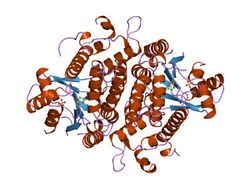Biology:Thymidine kinase from herpesvirus
| Thymidine kinase from herpesvirus | |||||||||||
|---|---|---|---|---|---|---|---|---|---|---|---|
 Structure of thymidine kinase from herpesvirus.[1] | |||||||||||
| Identifiers | |||||||||||
| Symbol | Herpes_TK | ||||||||||
| Pfam | PF00693 | ||||||||||
| InterPro | IPR001889 | ||||||||||
| SCOP2 | 1kin / SCOPe / SUPFAM | ||||||||||
| |||||||||||
Thymidine kinase from herpesvirus is a sub-family of thymidine kinases that catalyses the transfer of phospho group of ATP to thymidine to generate thymidine monophosphate, which serves as a substrate during viral DNA replication.[2][3]
Its presence in herpesvirus-infected cells is used to activate a range of antivirals against herpes infection, and thus specifically target the therapy towards infected cells only.
Such antivirals include:
- Purine analogues of guanine: Aciclovir, Famciclovir, Ganciclovir, Penciclovir, Valaciclovir, Valganciclovir
- Vidarabine
- Pyrimidine analogues of uridine: Idoxuridine, Trifluridine
- Brivudine
Mutations in the gene coding thymidine kinase in herpes viruses can endow the virus with resistance to aciclovir. In these situations, alternative medications that are of use include other guanine analogues such as famciclovir, valaciclovir and penciclovir.[4][5]
References
- ↑ "Exploring the active site of herpes simplex virus type-1 thymidine kinase by X-ray crystallography of complexes with aciclovir and other ligands". Proteins 32 (3): 350–361. August 1998. doi:10.1002/(SICI)1097-0134(19980815)32:3<350::AID-PROT10>3.0.CO;2-8. PMID 9715911.
- ↑ "Nucleoside binding site of herpes simplex type 1 thymidine kinase analyzed by X-ray crystallography". Proteins 41 (4): 545–553. December 2000. doi:10.1002/1097-0134(20001201)41:4<545::AID-PROT110>3.0.CO;2-8. PMID 11056041.
- ↑ "Crystal structures of the thymidine kinase from herpes simplex virus type-1 in complex with deoxythymidine and ganciclovir". Nature Structural Biology 2 (10): 876–881. October 1995. doi:10.1038/nsb1095-876. PMID 7552712.
- ↑ "Herpes simplex virus thymidine kinase mutations associated with resistance to acyclovir: a site-directed mutagenesis study". Antimicrobial Agents and Chemotherapy 49 (3): 1055–1059. March 2005. doi:10.1128/AAC.49.3.1055-1059.2005. PMID 15728902.
- ↑ "Synergistic antiviral activity of acyclovir and vidarabine against herpes simplex virus types 1 and 2 and varicella-zoster virus". Antiviral Research 72 (2): 157–161. November 2006. doi:10.1016/j.antiviral.2006.05.001. PMID 16797734.
 |

